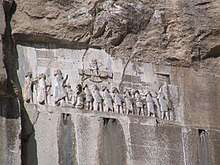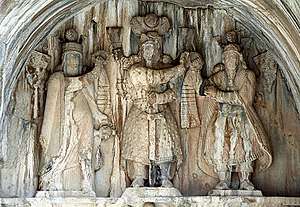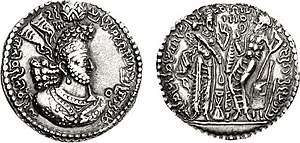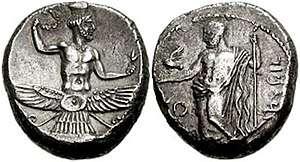Ahura Mazda
Ahura Mazda (/əˌhʊərə ˈmæzdə/;[1] Avestan: 𐬨𐬀𐬰𐬛𐬁 𐬀𐬵𐬎𐬭𐬀, romanized: Mazdā Ahura also known as Oromasdes, Ohrmazd, Ahuramazda, Hourmazd, Hormazd, and Hurmuz) is the creator and highest deity of Zoroastrianism. Ahura Mazda is the first and most frequently invoked spirit in the Yasna. The literal meaning of the word Ahura is "lord", and that of Mazda is "wisdom".
| Ahura Mazda | |
|---|---|
Lord of Wisdom | |
Sassanid relief at Naqsh-e Rostam showing Ahura Mazda presenting the diadem of sovereignty to Ardashir I | |
| Affiliation | Zoroastrianism |
| Region | Greater Iran |
| Personal information | |
| Siblings | Ahriman |
| Part of a series on |
| Zoroastrianism |
|---|
Atar (fire), a primary symbol of Zoroastrianism |
|
Primary topics |
|
Divine entities
|
|
Scripture and worship |
|
Accounts and legends |
|
Related topics |
|
|
| Part of a series on |
| God |
|---|
|
General conceptions |
|
In particular religions |
|
|
Related topics |
Ahura Mazda first appeared in the Achaemenid period (c. 550 – 330 BCE) under Darius I's Behistun Inscription. Until Artaxerxes II of Persia (405–04 to 359–58 BCE), Ahura Mazda was worshipped and invoked alone in all extant royal inscriptions. With Artaxerxes II, Ahura Mazda was invoked in a triad, with Mithra and Anahita. In the Achaemenid period, there are no known representations of Ahura Mazda at the royal court other than the custom for every emperor to have an empty chariot drawn by white horses, to invite Ahura Mazda to accompany the Persian army on battles. Images of Ahura Mazda, however, were present from the 5th century BCE, but were stopped and replaced with stone carved figures in the Sassanid period and later removed altogether through an iconoclastic movement supported by the Sassanid dynasty.
Nomenclature
"Ahura" is synonymous with the Vedic word "Asura" which means "lord".[2] Finnish Indologist, Asko Parpola, traces the etymological root of Asura to *asera- of Uralic languages, where it means "lord, prince".[3]
"Mazda", or rather the Avestan stem-form Mazdā-, nominative Mazdå, reflects Proto-Iranian *mazdáH (a feminine noun). It is generally taken to be the proper name of the spirit, and like its Vedic cognate medhā́, means "intelligence" or "wisdom". Both the Avestan and Sanskrit words reflect Proto-Indo-Iranian *mazdʰáH, from Proto-Indo-European *mn̥sdʰh₁éh₂, literally meaning "placing (*dʰeh₁) one's mind (*mn̥-s)", hence "wise".[4]
The name was rendered as Ahuramazda (Old Persian) during the Achaemenid era, Hormazd during the Parthian era, and Ohrmazd was used during the Sassanian era.[5]
The name may be attested on cuneiform tablets of Assyrian Assurbanipal, in the form Assara Mazaš, though this interpretation is very controversial.[6]
Characteristics
Even though it is speculated that Ahura Mazda was a spirit in the Indo-Iranian religion, he had not yet been given the title of "uncreated spirit". This title was given by Zoroaster, who proclaimed Ahura Mazda as the uncreated spirit, wholly wise, benevolent and good, as well as the creator and upholder of Asha.
Zoroaster's revelation
According to Zoroastrian tradition, at the age of 30, Zoroaster received a revelation: while fetching water at dawn for a sacred ritual, he saw the shining figure of the Amesha Spenta, Vohu Manah, who led Zoroaster to the presence of Ahura Mazda, where he was taught the cardinal principles of the "Good Religion" later known as Zoroastrianism. As a result of this vision, Zoroaster felt that he was chosen to spread and preach the religion.[7] He stated that this source of all goodness was the Ahura worthy of the highest worship. He further stated that Ahura Mazda created spirits known as yazatas to aid him, who also merited worship. Zoroaster proclaimed that some of the Iranian gods were daevas who deserved no worship. These "bad" deities were created by Angra Mainyu, the destructive spirit. The existence of Angra Mainyu was the source of all sin and misery in the universe. Zoroaster claimed that Ahura Mazda was not an omnipotent God, but used the aid of humans in the cosmic struggle against Angra Mainyu. Nonetheless, Ahura Mazda is Angra Mainyu's superior, not his equal. Angra Mainyu and his daevas, which attempt to attract humans away from the Path of Asha, would eventually be defeated.[8]
History
Achaemenid Empire

Whether the Achaemenids were Zoroastrians is a matter of much debate. However, it is known that the Achaemenids were worshipers of Ahura Mazda.[9] The representation and invocation of Ahura Mazda can be seen on royal inscriptions written by Achaemenid kings. The most notable of all the inscriptions is the Behistun Inscription written by Darius I which contains many references to Ahura Mazda. An inscription written in Greek was found in a late Achaemenid temple at Persepolis which invoked Ahura Mazda and two other deities, Mithra and Anahita. Amongst the earliest surviving inscription, on the Elamite Persepolis Fortification Tablet 377, Ahura Mazda is invoked along with Mithra and Apam Napat, Vedic Varuna ("water-god"). Artaxerxes III makes this invocation to the three deities again in his reign. In Vedic texts which predate these inscriptions by thousands of years, the Vedic gods Mithra and Varuna are frequently mentioned together. In the earliest layer of the Rigveda, Varuna is the guardian of moral law, the ruler over Asuras, one who punishes those who sin without remorse, and who forgives those who err with remorse. He is the Guardian deity of the West, meaning regions west of India.[10][11] He is mentioned in many Rigvedic hymns, such as 7.86–88, 1.25, 2.27–30, 8.8, 9.73 and others.[10][12] His relationship with waters, rivers and oceans is mentioned in the Vedas.[13] Vedic poets describe him as an aspect and one of the plural perspectives of the Agni, one of the Primary deities.[14][15] Further, both have wrathful-gracious aspects in Indian mythology.
The early Achaemenid period contained no representation of Ahura Mazda. The winged symbol with a male figure who was formerly regarded by European scholars as Ahura Mazda has been now speculated to represent the royal xvarənah, the personification of divine power and royal glory. However, it was customary for every emperor from Cyrus until Darius III to have an empty chariot drawn by white horses as a place for Ahura Mazda to accompany the Persian army on battles. The use of images of Ahura Mazda began in the western satraps of the Achaemenid Empire in the late 5th century BCE. Under Artaxerxes II, the first literary reference as well as a statue of Ahura Mazda was built by a Persian governor of Lydia in 365 BCE.[16]
Parthian Empire
It is known that the reverence for Ahura Mazda, as well as Anahita and Mithra continued with the same traditions during this period. The worship of Ahura Mazda with symbolic images is noticed, but it stopped within the Sassanid period. Zoroastrian iconoclasm, which can be traced to the end of the Parthian period and the beginning of the Sassanid, eventually put an end to the use of all images of Ahura Mazda in worship. However, Ahura Mazda remained symbolized by a dignified male figure, standing or on horseback which is found in Sassanian investiture.[16]
Sassanid Empire


During the Sassanid Empire, a heretical and divergent[17][18][19] form of Zoroastrianism, termed Zurvanism, emerged. It gained adherents throughout the Sassanid Empire, most notably the royal lineage of Sassanian emperors. Under the reign of Shapur I, Zurvanism spread and became a widespread cult. Zurvanism revokes Zoroaster's original message of Ahura Mazda as the uncreated spirit, and the "uncreated creator" of all, and reduces him to a created spirit, one of two twin sons of Zurvan, their father and the primary spirit. Zurvanism also makes Ahura Mazda and Angra Mainyu of equal strength and only contrasting spirits.
Other than Zurvanism, the Sassanian kings demonstrated their devotion to Ahura Mazda in other fashions. Five kings took the name Hormizd and Bahram II created the title of "Ohrmazd-mowbad" which was continued after the fall of the Sassanid Empire and through the Islamic times. All devotional acts in Zoroastrianism originating from the Sassanian period begin with homage to Ahura Mazda. The five Gāhs begin with the declaration in Middle Persian, that "Ohrmazd is Lord" and incorporate the Gathic verse "Whom, Mazda hast thou appointed my protector". Zoroastrian prayers are to be said in the presence of light, either in the form of fire or the sun. In the Iranian dialects of Yidḡa and Munǰī, the sun is still called "ormozd".[16]
Present-day Zoroastrianism
In 1884, Martin Haug proposed a new interpretation of Yasna 30.3 that subsequently influenced Zoroastrian doctrine to a significant extent. According to Haug's interpretation, the "twin spirits" of 30.3 were Angra Mainyu and Spenta Mainyu, the former being literally the "Destructive Spirit"[n 1] and the latter being the "Bounteous Spirit" (of Ahura Mazda). Further, in Haug's scheme, Angra Mainyu was now not Ahura Mazda's binary opposite, but—like Spenta Mainyu—an emanation of Him. Haug also interpreted the concept of a free will of Yasna 45.9 as an accommodation to explain where Angra Mainyu came from since Ahura Mazda created only good. The free will made it possible for Angra Mainyu to choose to be evil. Although these latter conclusions were not substantiated by Zoroastrian tradition,[4] at the time Haug's interpretation was gratefully accepted by the Parsis of Bombay since it provided a defense against Christian missionary rhetoric,[n 2] particularly the attacks on the Zoroastrian idea of an uncreated Evil that was as uncreated as God was. Following Haug, the Bombay Parsis began to defend themselves in the English-language press, the argument being that Angra Mainyu was not Mazda's binary opposite, but his subordinate, who—as in Zurvanism also—chose to be evil. Consequently, Haug's theories were disseminated as a Parsi interpretation, also in the West, where they appeared to be corroborating Haug. Reinforcing themselves, Haug's ideas came to be iterated so often that they are today almost universally accepted as doctrine.[16][20][n 3]
In other religions
Some scholars (Kuiper. IIJ I, 1957; Zimmer. Münchner Studien 1984:187–215) believe that Ahura Mazda originates from *vouruna-mitra, or Vedic Varuna (and Mitra).[21] According to William W Malandra both Varuna (in Vedic period) and Ahura Mazda (in old Iranian religion) represented same Indo-Iranian concept of a supreme "wise, all-knowing lord".[22]
In Manichaeism, the name Ohrmazd Bay ("god Ahura Mazda") was used for the primal figure Nāšā Qaḏmāyā, the "original man" and emanation of the Father of Greatness (in Manicheism called Zurvan) through whom after he sacrificed himself to defend the world of light was consumed by the forces of darkness. Although Ormuzd is freed from the world of darkness his "sons", often called his garments or weapons, remain. His sons, later known as the World Soul after a series of events will for the most part escape from matter and return again to the world of light where they came from. Manicheans often identified many of Mani's cosmological figures with Zoroastrian ones. This may be in part because Mani was born in the greatly Zoroastrian Parthian Empire.
In Sogdian Buddhism, Xwrmztʼ (Sogdian was written without a consistent representation of vowels) was the name used in place of Ahura Mazda.[23][24] Via contacts with Turkic peoples like the Uyghurs, this Sogdian name came to the Mongols, who still name this deity Qormusta Tengri (Also Qormusta or Qormusda) is now a popular enough deity to appear in many contexts that are not explicitly Buddhist.[25]
The pre-Christian Armenians had Aramazd as an important deity in their pantheon of gods. He is thought to be a syncretic deity, a combination of the autochthonous Armenian figures Aram and his son Ara and the Iranian Ahura Mazda. In modern-day Armenia, Aramazd is a male first name.
101 Names
- yazat ("Worthy of worship.")
- harvasp-tavãn ("Omnipotent.")
- harvasp-âgâh ("Omniscient.")
- harvasp-h'udhâ ("The Lord of all.")
- abadah ("Without beginning.")
- awî-añjâm ("Without end.")
- bûnastah ("The origin of the formation of the world.")
- frâxtañtah ("Broad end of all.")
- jamakh ("Greatest cause.")
- parjahtarah ("More exalted.")
- tum-afayah ("Most innocent.")
- abravañt ("Apart from everyone.")
- parvañdah ("Relation with all.")
- an-ayâfah ("Incomprehensible by anyone.")
- ham-ayâfah ("Comprehensible of all.")
- âdharô ("Most straight, most just.")
- gîrâ ("Holding fast all.")
- acim ("Without reason.")
- cimnâ ("Reason of reasons.")
- safinâ ("Increaser.")
- âwzâ ("Causer of increase. The Lord of purity")
- nâshâ ("Reaching all equally.")
- parvarâ ("Nourisher.")
- âyânah ("Protector of the world.")
- âyaîn-âyânah ("Not of various kinds.")
- an-âyanah ("Without form.")
- xraoshît-tum ("Firmest.")
- mînôtum ("Most invisible.")
- vâsnâ ("Omnipresent.")
- harvastum ("All in all.")
- husipâs ("Worthy of thanks.")
- har-hemît ("All good-natured.")
- harnekfareh ("All good auspicious-glory.")
- beshtarnâ ("Remover of affliction.")
- tarônîs ("The triumphant.")
- anaoshak ("Immortal.")
- farashak ("Fulfiller of wishes.")
- pazohadhad ("Creator of good nature.")
- xavâpar ("Beneficient.")
- awaxshâyâ ("Bestower of Love.")
- awarzâ ("Excessive bringer.”)
- â-sitôh ("Undefeated, undistressed.")
- raxôh ("Independent, carefree.")
- varûn ("Protector from evil.")
- a-frîpah ("Undeceivable.")
- awe-frîftah ("Undeceived.")
- adhvaî ("Unparalleled.")
- kãme-rat ("Lord of wishes.")
- framãn-kãm ("Only wish is His command.")
- âyextan ("Without body.")
- â-framôsh ("Unforgetful.")
- hamârnâ ("Taker of accounts.")
- snâyâ ("Recognizable, worth recognition.")
- a-tars ("Fearless.")
- a-bîsh ("Without affliction or torment.")
- a-frâzdum ("Most exalted.")
- hamcûn ("Always uniform.")
- mînô-stîgar ("Creator of the Universe spiritually.")
- a-mînôgar ("Creator of much spirituality.")
- mînô-nahab ("Hidden in Spirits.")
- âdhar-bâtgar ("Air of fire, i.e. transformer into air.")
- âdhar-namgar ("Water of fire, i.e. transformer into water.")
- bât-âdhargar ("Transformer of air into fire.")
- bât-namgar ("Transformer of air into water.")
- bât-gelgar ("Transformer of air into earth.")
- bât-girdtum ("Transformer of air into girad, i.e. gathered.")
- âdhar-kîbarît-tum ("Transformer of fire into jewels.")
- bâtgarjâi ("Who creates air in all places.")
- âwtum ("Creator of most excessive water.")
- gel-âdhargar ("Transformer of the earth into fire.")
- gel-vâdhgar ("Transformer of the earth into air.")
- gel-namgar ("Transformer of the earth into water.")
- gargar ("Artisan of artisans.")
- garôgar ("Bestower of wishes.")
- garâgar ("Creator of man")
- garâgargar ("Creator of the entire creation")
- a-garâgar ("Creator of four elements)"
- a-garâgargar ("Creator of clusters of the stars")
- a-gûmãn ("Without doubt.")
- a-jamãn ("Without time.")
- a-h'uãn ("Without sleep.")
- âmushthushyâr ("Intelligent.")
- frashûtanâ ("Eternal protector-increaser.")
- padhamãnî ("Maintainer of padman, i.e. the golden mean.")
- pîrôzgar ("Victorious.")
- h'udhâvañd ("Lord-Master of the Universe.")
- ahuramazda ("Lord Omniscient.")
- abarînkuhantavãn ("Of the most exalted rank in the power of maintaining the origin of the creations.")
- abarîn-nô-tavã ("Of the most exalted rank in the power of rendering the creations anew.")
- vaspãn ("Attainer to all the creations.")
- vaspâr ("Bringer of and attainer to all.")
- h'âwar ("Merciful.")
- ahû ("Lord of the world.")
- âwaxsîdâr ("Forgiver.")
- dâdhâr ("The just creator.")
- rayomañd ("Full of rae-lustre-splendour.")
- h'arehmand ("Full of khoreh, i.e. glory.")
- dâwar ("The just judge.")
- kerfagar ("Lord of meritorious deeds.")
- buxtâr ("Redeemer, saviour.")
- frashôgar ("Restorer through increase of the soul.")
In popular culture

- Ormazd and Ahriman feature in the 2008 video game, Prince of Persia.
- Ormuhzd and Ahriman are two characters in the Warhammer 40,000 Franchise. Ahriman has a model, whereas Ormuhzd is only referenced in the book A Thousand Sons
- Ormazd and Ahriman feature heavily in the Philip K. Dick novel The Cosmic Puppets.
- In the 2001 video game Severance: Blade of Darkness, Ahura Mazda was the god who created the entire world in which the game takes place.
- General Electric exploited the association of the name with light for their brand of Mazda light bulbs.
- One of the inspirations for the name of the Mazda Motor Corporation is Ahura Mazda, with homophone similarity to founder Jujiro Matsuda.
- A statue of Ahura Mazda is built to contain the Djinn in the film Wishmaster.
- In the 2013 Amish Tripathi novel The Oath of the Vayuputras, Ahura Mazda is shown as the God of Pariha.
- Ahura Mazda is mentioned in the Immortal Technique song "Sign of the Times" from the album The Martyr.
- In the novel Battle Royale, a student named Mizuho Inada believes she is a warrior for the god Ahura Mazda.
- Ahura Mazda appears as a character in the Lucifer's Halo miniseries of Joseph Michael Linsner's comic Dawn.
- Ahura Mazda was the name of a late 1960s, early 1970s psychedelic and fusion prog-rock band from the Netherlands.
- Ahura Mazda is featured in the book Kushiel's Avatar, the third novel in Jacqueline Carey's Kushiel's Legacy series.
- In the MMORPG Final Fantasy XIV, Ahura Mazda is the ultimate move of the third god of the Warring Triad, Zurvan.
- Ahriman appears as a character in the television show Highlander: The Series.
See also
Notes
- For an explanation of the approximation of mainyu as "spirit", see Angra Mainyu.
- Most prominent of these voices was that of the Scottish Presbyterian minister Dr. John Wilson, whose church was next door to the M. F. Cama Athornan Institute, the premier school for Zoroastrian priests. That the opinions of the Zoroastrian priesthood is barely represented in the debates that ensued was to some extent due to the fact that the priesthood spoke Gujarati and not English, but also because they were (at the time) poorly equipped to debate with a classically trained theologian on his footing. Wilson had even taught himself Avestan.
- For a scholastic review of the theological developments in Indian Zoroastrianism, particularly with respect to the devaluation of Angra Mainyu to a position where the (epitome of) pure evil became viewed as a creation of Mazda (and so compromised their figure of pure good), see Maneck 1997
References
- "Ahura Mazda | Definition of Ahura Mazda by Merriam-Webster". Merriam-webster.com. Retrieved 2016-01-11.
- David S. Noss, Blake Grangaard. A History of the World's Religions. Routledge, 2016.
- Asko Parpola (2015), The Roots of Hinduism: The Early Aryans and the Indus Civilization, Oxford University Press, ISBN 978-0190226923, pages 114-116
- Boyce 1983, p. 685.
- Boyce 1985, p. 685.
- Boyce 1975, p. 14.
- Nigosian 1993, p. 12.
- Andrea 2000, p. 86.
- Bromiley 1995, p. 126.
- Mariasusai Dhavamony (1982). Classical Hinduism. Gregorian. pp. 167–168 with footnotes. ISBN 978-88-7652-482-0.
- John Gwyn Griffiths (1991). The Divine Verdict: A Study of Divine Judgement in the Ancient Religions. BRILL. pp. 132–133. ISBN 90-04-09231-5.
- Adrian Snodgrass (1992). The Symbolism of the Stupa. Motilal Banarsidass. pp. 120–122 with footnotes. ISBN 978-81-208-0781-5.
- Hermann Oldenberg (1988). The Religion of the Veda. Motilal Banarsidass. p. 104. ISBN 978-81-208-0392-3.
- Hermann Oldenberg (1988). The Religion of the Veda. Motilal Banarsidass. p. 51. ISBN 978-81-208-0392-3.
- Moriz Winternitz (1996). A History of Indian Literature. Motilal Banarsidass. pp. 91–92. ISBN 978-81-208-0264-3.
- Boyce 1983, p. 686.
- Corduan 1998, p. 123.
- King 2005, p. 314.
- Whitrow 2003, p. 8.
- Maneck 1997, pp. 182ff.
- Varuna#In Zoroastrianism
- William W. Malandra. An Introduction to Ancient Iranian Religion. 1983. p. 46
- Unknown 1999, p. 429.
- Frye 1996, p. 247.
- Sims-Williams 1992, p. 44.
Bibliography
- Boyce, Mary (1975), History of Zoroastrianism, Vol. I, The early period, Leiden: Brill
- Boyce, Mary (1982), History of Zoroastrianism, Vol. II, Under the Achamenians, Leiden: Brill
- Boyce, Mary (1983), "Ahura Mazdā", Encyclopaedia Iranica, 1, New York: Routledge & Kegan Paul, pp. 684–687
- Maneck, Susan Stiles (1997), The Death of Ahriman: Culture, Identity and Theological Change Among the Parsis of India, Bombay: K. R. Cama Oriental Institute
- Sims-Williams, Nicholas (1992), Sogdian and other Iranian inscriptions of the Upper Indus, University of Michigan, ISBN 978-0-7286-0194-9
- Andrea, Alfred; James H. Overfield (2000), The Human Record: Sources of Global History : To 1700, 4 (Illustrated ed.), Houghton Mifflin Harcourt, ISBN 978-0-618-04245-6
- Corduan, Winfried (1998), Neighboring faiths: a Christian introduction to world religions, InterVarsity Press, ISBN 978-0-8308-1524-1
- Frye, Richard Nelson (1996), The heritage of Central Asia from antiquity to the Turkish expansion, Markus Wiener Publishers, ISBN 978-1-55876-111-7
- Unknown (1999), History of civilizations of Central Asia, Volume 3, Motilal Banarsidass Publ
- King, Karen L. (2005), What is Gnosticism?, Harvard University Press, ISBN 978-0-674-01762-7
- Whitrow, G. J. (2003), What is time?, Oxford University Press, ISBN 978-0-19-860781-6
- Bromiley, Geoffrey (1995), The International Standard Bible Encyclopedia: Q-Z, Wm. B. Eerdmans Publishing, ISBN 978-0-8028-3784-4
- Nigosian, Solomon (1993), The Zoroastrian faith: tradition and modern research, McGill-Queen's Press – MQUP, ISBN 978-0-7735-1144-6
Further reading
- Ahuramazda and Zoroastrianism
- Dhalla, Maneckji Nusservanji (1938), History of Zoroastrianism, New York: OUP, ISBN 0-404-12806-8
- Boyce, Mary (2001), "Mithra the King and Varuna the Master", Festschrift für Helmut Humbach zum 80., Trier: WWT, pp. 239–257
- Humbach, Helmut (1991), The Gathas of Zarathushtra and the other Old Avestan texts, Heidelberg: Winter, ISBN 3-533-04473-4
- Kent, Roland G. (1945), "Old Persian Texts", Journal of Near Eastern Studies, 4 (4): 228–233, doi:10.1086/370756
- Kuiper, Bernardus Franciscus Jacobus (1983), "Ahura", Encyclopaedia Iranica, 1, New York: Routledge & Kegan Paul, pp. 682–683
- Kuiper, Bernardus Franciscus Jacobus (1976), "Ahura Mazdā 'Lord Wisdom'?", Indo-Iranian Journal, 18 (1–2): 25–42, doi:10.1163/000000076790079465
- Ware, James R.; Kent, Roland G. (1924), "The Old Persian Cuneiform Inscriptions of Artaxerxes II and Artaxerxes III", Transactions and Proceedings of the American Philological Association, The Johns Hopkins University Press, 55: 52–61, doi:10.2307/283007, JSTOR 283007
- Kent, Roland G. (1950), Old Persian: Grammar, texts, lexicon, New Haven: American Oriental Society, ISBN 0-940490-33-1
- Andrea, Alfred; James H. Overfield (2000), The Human Record: Sources of Global History : To 1700, 4 (Illustrated ed.), Houghton Mifflin Harcourt, ISBN 978-0-618-04245-6
- Schlerath, Bernfried (1983), "Ahurānī", Encyclopaedia Iranica, 1, New York: Routledge & Kegan Paul, pp. 683–684
